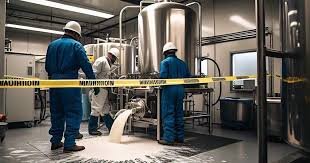How does equipment malfunction impact pharmaceutical production processes?

Equipment malfunction in pharmaceutical production can have wide-ranging and serious implications, affecting not only operational efficiency but also regulatory compliance, product quality, and patient safety. Here’s a detailed explanation of how such malfunctions can impact the production process:
1. Production Downtime
-
Impact: When equipment fails, production lines often come to a halt, leading to delays in manufacturing schedules.
-
Consequences: This can disrupt supply chains, cause missed delivery deadlines, and lead to financial losses due to idle labor and wasted utilities.
2. Product Quality and Consistency
-
Impact: Malfunctioning equipment may not operate within validated parameters, leading to variations in product quality.
-
Examples: A malfunctioning granulator could produce granules of inconsistent size, or an autoclave that doesn’t reach proper sterilization temperatures could leave products contaminated.
-
Consequence: Such deviations can result in batches that must be rejected, reworked, or recalled.
3. Regulatory Non-compliance
-
Impact: Pharmaceutical manufacturing is heavily regulated (e.g., by FDA, EMA). Equipment must meet Good Manufacturing Practice (GMP) standards.
-
Consequences: Equipment failure that affects product quality or process integrity may lead to regulatory citations, warning letters, or even plant shutdowns.
4. Contamination Risks
-
Impact: Defective equipment (e.g., cracked pipes, leaky seals, worn-out filters) can lead to microbial or cross-contamination.
-
Consequence: This poses a direct risk to patient safety and may result in product recalls or liability issues.
5. Increased Operational Costs
-
Impact: Reworking batches, conducting investigations, and repairing or replacing faulty equipment all add to costs.
-
Consequence: Increased cost per unit produced, which may affect profitability.
6. Data Integrity and Process Control Issues
-
Impact: Malfunctions in electronic equipment such as sensors, data loggers, or control systems can lead to incorrect data recording.
-
Consequence: This undermines the reliability of batch records, potentially invalidating an entire production lot.
7. Impact on Worker Safety
-
Impact: Equipment failures can create unsafe working conditions—e.g., overheating, chemical leaks, or mechanical hazards.
-
Consequence: This may result in injuries, legal liabilities, and workforce morale issues.
8. Delays in Drug Approval and Market Supply
-
Impact: In development stages, equipment issues can delay clinical batch production or scale-up.
-
Consequence: This can delay regulatory filings or the time it takes for a drug to reach the market.
Conclusion:
Equipment malfunction in pharmaceutical manufacturing is not just a technical issue—it has broad implications for quality, compliance, financial performance, and public health. This is why preventive maintenance, real-time monitoring, and robust quality systems are critical components of modern pharmaceutical production.
🎓 Discover one of the best Quality Assurance courses available — click below to explore the course that’s shaping future QA skills.https://trcjw.on-app.in/app/oc/306166/trcjw

